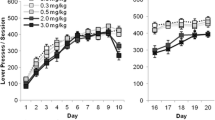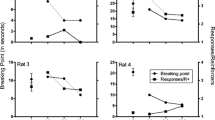Abstract
This experiment was undertaken to provide a pharmacological characterization of performance on a task involving food-related instrumental and consummatory behavior. Rats were tested in an operant chamber in which there was a choice between pressing a lever to receive a preferred food (Bioserve pellets) or approaching and consuming a less-preferred food (Lab Chow). The lever pressing schedule was a fixed ratio 5 (FR5). Rats usually pressed the lever at high rates to obtain the preferred food, and typically ate little of the lab chow even though it was freely available in the chamber concurrently with the lever pressing schedule. Previous work has shown that injection of dopamine (DA) antagonists, or depletion of DA in the nucleus accumbens, caused a substantial shift in behavior such that lever pressing was reduced but chow consumption increased. In the present study it was shown that the DA antagonist haloperidol decreased lever pressing and increased chow consumption at doses of 0.1 and 0.15 mg/kg. The D1 antagonist SCH 23390 (0.05, 0.1 and 0.15 mg/kg) and the non-selective DA antagonistcis-flupenthixol (0.3 and 0.45 mg/kg) decreased lever pressing and produced substantial increases in chow consumption. The D2 antagonist sulpiride decreased lever pressing, but produced only slight increases in chow intake at the highest dose. Pentobarbital reduced lever pressing and increased chow consumption at 10.0 mg/kg. The muscarinic agonist pilocarpine produced dose-related decreases in lever pressing, but failed to increase chow consumption. Amphetamine produced dose-related decreases in both lever pressing and chow consumption. These results indicate that low/moderate doses of the DA antagonists haloperidol,cis-flupenthixol and SCH 23390 can suppress lever pressing in doses that leave the animal directed towards food acquisition and consumption.
Similar content being viewed by others
References
Altar CA, Hauser K (1987) Topography of substantia nigra innervation by D1 receptor-containing striatal neurons. Brain Res 410:1–11
Beninger RJ, Cheng M, Hahn BL, Hoffman DC, Mazurski EJ, Morencey MA, Ramm P, Stewart RJ (1987) Effects of extinction, pimozide, SCH 23390, and metoclopramide on food-rewarded operant responding of rats. Psychopharmacology 92:343–349
Billard W, Ruperto V, Crosby, Iorio LC, Barnett A (1984) Characterization of the binding of 3H-SCH 23390, a selective D-1 receptor antagonist ligand, in rat striatum. Life Sci 35:1885–1893
Blundell JR (1987) Structure, process and mechanism: case studies in the psychopharmacology of feeding. In: Iversen LL, Iversen SD, Snyder SH (eds) Handbook of psychopharmacology. Plenum Press, New York, pp 123–181
Boyson SJ, McGonigle P, Molinoff PB (1986) Quantitative autoradiographic localization of the D1 and D2 subtypes of dopamine receptors in rat brain. J Neurosci 6:3177–3188
Cador M, Taylor JR, Robbins TW (1991) Potentiation of the effects of reward-related stimuli by dopaminergic-dependent mechanisms in the nucleus accumbens. Psychopharmacology 104:377–385
Cools AR, Hendriks G, Korten J (1975) The acetylcholine-dopamine balance in the basal ganglia of Rhesus monkeys and its role in dynamic, dystonic, dyskinetic epileptoid motor activities. J Nerv Transm 36:91–105
Cousins MS, Salamone JD (1994) Nucleus accumbens dopamine depletions in rats affect relative response allocation in a novel cost/benefit procedure. Pharmacol Biochem Behav (in press)
Cousins MS, Sokolowski JD, Salamone JD (1993) Different effects of nucleus accumbens and ventrolateral striatal dopamine depletions on instrumental response selection in the rat. Pharmacol Biochem Behav 46:943–951
Duvoisin RC (1967) Cholinergic-anticholinergic antagonism in parkinsonism. Arch Neurol 17:124–136
Ettenberg A, Koob GF, Bloom F (1981) Response artifact in the measurement of neuroleptic-induced anhedonia. Science 209:357–359
Everitt BJ, Cador M, Robbins TW (1989) Interactions between the amygdala and ventral striatum in stimulus-reward associations: Studies using a second-order schedule of sexual reinforcement. Neuroscience 30:63–75
Fibiger HC, Carter DA, Phillips AG (1976) Decreased intracranial self-stimulation after neuroleptics or 6-hydroxydopamine: evidence for mediation by motor deficits rather than by reduced reward. Psychopharmacology 47:21–27
Gingrich JA, Caron MG (1993) Recent advances in the molecular biology of dopamine receptors. Annu Rev Neurosci 16:299–321
Hammond EO, Torok ML, Ettenberg A (1991) Different patterns of behavior produced by haloperidol, pentobarbial, and dantrolene in tests of unconditioned locomotion and operant responding. Psychopharmacology 104:150–156
Holzman SG, Jewitt RE (1971) The role of brain norepinephrine in the anorexic effects of dextroamphetamine and monoamine oxidase inhibitors in the rat. Psychopharmacology 22:251–255
Horvitz JC, Richardson WB, Ettenberg A (1993) Dopamine receptor blockade and reductions in thirst produce differential effects on drinking behavior. Pharmacol Biochem Behav 45:725–728
Hursh SR, Raslear TG, Shurtleff D, Bauman R, Simmons L (1988)988) A cost-benefit analysis of demand for food. J Exp Anal Behav 50:419–440
Janssen PA, Niemegeers CJF, Schellekens KHL (1965) Is it possible to predict the clinical effects of neuroleptic drugs (major tranquilizers) from animal data? Arzneimittelforschung 15:104–117
Jicha GA, Salamone JD (1991) Vacuous jaw movements and feeding deficits in rats with ventrolateral striatal dopamine depletion: possible relation to parkinsonian symptoms. J Neurosci 11:3822–3829
Joyce JN, Loeschen SK, Marshall JF (1985) Dopamine D-2 receptors in rat caudate-putamen: the lateral to medial gradient does not correspond to dopaminergic innervation. Brain Res 338:209–218
Kelley AE, Delfs JM (1991) Dopamine and conditioned reinforcement II. Contrasting effects of amphetamine microinjection into the nucleus accumbens with peptide microinjection into the ventral tegmental area. Psychopharmacology 103:197–203
Keppel G (1982) Design and Analysis:is: a researcher's handbook. Prentice-Hall, Englewood Cliffs, NJ
Leibowitz SF, Rossakis C (1978) Analysis of feeding suppression produced by perifornical hypothalamic injection of catecholamines, amphetamines and mazindol. Eur J Pharmacol 53:69–81
Ljungberg T (1987) Blockade by neuroleptics of water intake and operant responding in the rat:: anhedonia, motor deficit or both? Pharmacol Biochem Behav 27:341–350
Ljungberg T (1988) Scopolamine reverses haloperidol-attenuated lever pressing for water but not haloperidol-attenuated water intake in the rat. Pharmacol Biochem Behav 29:205–208
Ljungberg T (1989) Effects of the dopamine D-1 antagonist SCH 23390 on water intake, water-rewarded operant responding and apomorphine induced decrease of water in rats. Pharmacol Biochem Behav 33:709–712
Ljungberg T (1990) Differential attenuation of water intake and water-rewarded operant responding by repeated administration of haloperidol and SCH 23390 in the rat. Pharmacol Biochem Behav 35:111–115
Marshall JF, Richardson JS, Teitelbaum P (1974) Nigrostriatal damage and the lateral hypothalamic syndrome. J Comp Physiol Psychol 87:808–830
Martin-Iverson MT, Wilke D, Fibiger HC (1987) Effect of haloperidol and d-amphetamine on perceived quantity of food and tones. Psychopharmacology 93:374–381
Mason ST, Beninger RJ, Fibiger HC, Phillips AG (1980) Pimozide-induced suppression of responding: evidence against a block of food reward. Pharmacol Biochem Behav 12:917–923
McCullough LD, Salamone JD (1992) Involvement of nucleus accumbens dopamine in the motor activity induced by periodic food presentation: a microdialysis and behavioral study. Brain Res 592:29–36
Mekarski JE (1989) Main effects of current and pimozide on prepared and learned self-stimulation behaviors are on performance not reward. Pharmacol Biochem Behav 31:845–853
Mittleman G, Whishaw IQ, Jones GH, Koch M, Robbins TW (1990) Cortical, hippocampal, and striatal mediation of schedule-induced behaviors. Behav Neurosci 104:399–409
Mogenson G, Jones D, Yim CY (1980) From motivation to action: functional interface between the limbic system and the motor system. Prog Neurobiol 14:69–97
Muscat R, Willner P (1989) Effects of dopamine receptor antagonists on sucrose consumption and preference. Psychopharmacology 99:98–102
Osborne SR (1977) The free food (contrafreeloading) phenomenon: a review and analysis. Anim Learn Behav 5:221–235
Rachlin HH (1981) Absolute and relative consumption space. In: Bernstein D (ed) Response structure and organization. University of Nebraska Press, Lincoln
Robbins TW, Koob GF (1980) Selective disruption of displacement behaviour by lesions of the mesolimbic dopamine system. Nature 285:409–412
Rolls ET, Rolls BJ, Kelly PH, Shaw SG, Wood RJ, Dale R (1974) The relative attenuation of self-stimulation, eating and drinking produced by dopamine-receptor blockade. Psychopharmacology 38:219–230
Salamone JD (1986) Different effects of haloperidol and extinction on instrumental behaviors. Psychopharmacology 88:18–23
Salamone JD (1987) The actions of neuroleptic drugs on appetitive instrumental behaviors. In: Iversen LL, Iversen SD, Snyder SH (eds) Handbook of psychopharmacology. Plenum Press, New York, pp 575–608
Salamone JD (1988) Dopaminergic involvement in activational aspects of motivation: effects of haloperidol on schedule-induced activity, feeding and foraging in rats. Psychobiology 16:196–206
Salamone JD (1991) Behavioral pharmacology of dopamine systems: a new synthesis. In: Willner P, Scheel-Kruger J (eds) The mesolimbic dopamine system: from motivation to action. Wiley, Chichester, England, pp 599–613
Salamone JD (1992) Complex motor and sensorimotor functions of striatal and accumbens dopamine: involvement in instrumental behavior processes. Psychopharmacology 107:160–174
Salamone JD, Cousins MS, Bucher S (1994) Anhedonia or anergia? Effects of haloperidol and nucleus accumbens dopamine depletion on instrumental response selection in a T-maze cost/benefit procedure. Behav Brain Res (in press)
Salamone JD, Lalies MD, Channell SL, Iversen SD (1986) Behavioral and pharmacological characterization of the mouth movements induced by muscarinic agonists in the rat. Psychopharmacology 88:467–471
Salamone JD, Johnson CJ, McCullough LD, Steinpreis RE (1990a) Lateral striatal cholinergic mechanisms involved in oral motor activities in the rat. Psychopharmacology 102:529–534
Salamone JD, Zigmond MJ, Stricker EM (1990b) Characterization of the impaired feeding behavior in rats given haloperidol or dopamine-depleting brain lesions. Neuroscience 39:17–24
Salamone JD, Steinpreis RE, McCullough LD, Smith P, Grebel D, Mahan K (1991) Haloperidol and nucleus accumbens dopamine depletion suppress lever pressing for food but increase free food consumption in a novel food-choice procedure. Psychopharmacology 104:515–521
Salamone JD, Kurth PA, McCullough LD, Sokolowski JD, Cousins MS (1993a) The role of dopamine in response initiation: effects of haloperidol and regionally-specific dopamine depletions on the local rate of instrumental responding. Brain Res 62:218–266
Salamone JD, Mahan K, Rogers S (1993b) Ventrolateral striatal dopamine depletions impair feeding and food handling in rats. Pharmacol Biochem Behav 44:605–610
Staddon JE (1979) Operant behavior as adaptation to constraint. J Exp Psychol Gen 108:48–67
Staddon JE (1983) Adaptive behavior and learning. Cambridge University Press, Cambridge, England
Steinpreis RE, Baskin P, Salamone JD (1993) Vacuous jaw movements induced by sub-chronic administration of haloperidol: interactions with scopolamine. Psychopharmacology 111:99–105
Stricker EM, Zigmond MJ (1976) Recovery of function after damage to central catecholamine-containing neurons: a neurochemical model for the lateral hypothalamic syndrome. In: Sprague JM (ed) Progress in psychobiology and physiological psychology. Academic Press, New York, pp 121–173
Taylor JR, Robbins TW (1984) Enhanced behavioral control by conditioned reinforcers following microinjections of D-amphetamine into the nucleus accumbens. Psychopharmacology. 84:405–412
Taylor JR, Robbins TW (1986) 6-Hydroxydopamine lesions of the nucleus accumbens but not the caudate nucleus attenuate responding with reward-related stimului produced by intra-accumbens D-amphetamine. Psychopharmacology 90:390–397
Ungerstedt U (1971) Adipsia and aphagia after 6-hydroxydopamine- induced degeneration of the nigro-striatal dopamine system. Acta Physiol Scand 83 [suppl. 367]:95–122
Wise RA (1982) Neuroleptics and operant behavior: the anhedonia hypothesis. Behav Brain Sci 5:39–87
Wise RA (1985) The anhedonia hypothesis: mark III. Behav Brain Sci 8:178–186
Wise RA, Spindler J, DeWitt H, Gerber GJ (1978a) Pimozide blocks reward quality of food. Science 201:262–264
Wise RA, Spindler J, Legault L (1978b) Major attenuation of food reward with performance-sparing doses of pimozide in the rat. Can J Psychol 32:77–85
Author information
Authors and Affiliations
Rights and permissions
About this article
Cite this article
Cousins, M.S., Wei, W. & Salamone, J.D. Pharmacological characterization of performance on a concurrent lever pressing/feeding choice procedure: effects of dopamine antagonist, cholinomimetic, sedative and stimulant drugs. Psychopharmacology 116, 529–537 (1994). https://doi.org/10.1007/BF02247489
Received:
Revised:
Issue Date:
DOI: https://doi.org/10.1007/BF02247489




